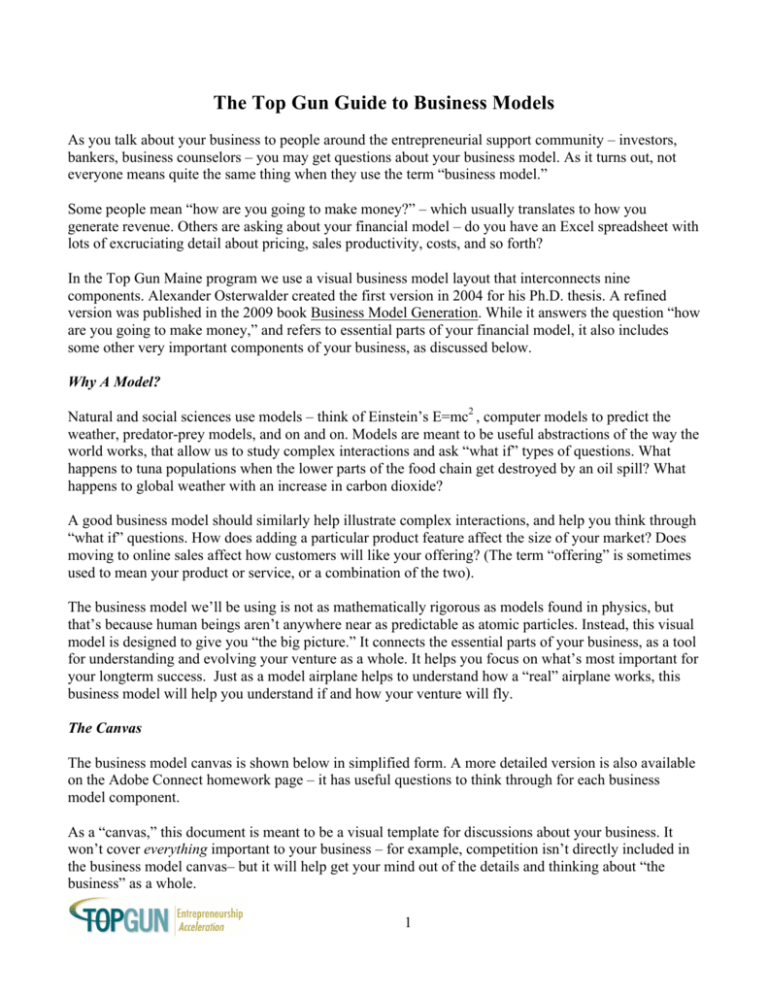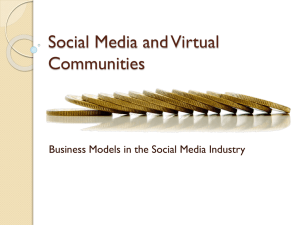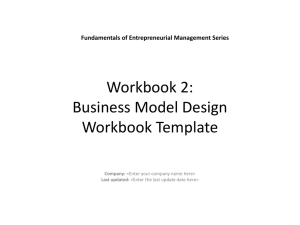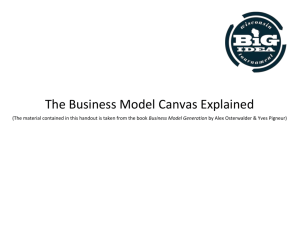The Top Gun Guide to Business Models
advertisement

The Top Gun Guide to Business Models As you talk about your business to people around the entrepreneurial support community – investors, bankers, business counselors – you may get questions about your business model. As it turns out, not everyone means quite the same thing when they use the term “business model.” Some people mean “how are you going to make money?” – which usually translates to how you generate revenue. Others are asking about your financial model – do you have an Excel spreadsheet with lots of excruciating detail about pricing, sales productivity, costs, and so forth? In the Top Gun Maine program we use a visual business model layout that interconnects nine components. Alexander Osterwalder created the first version in 2004 for his Ph.D. thesis. A refined version was published in the 2009 book Business Model Generation. While it answers the question “how are you going to make money,” and refers to essential parts of your financial model, it also includes some other very important components of your business, as discussed below. Why A Model? Natural and social sciences use models – think of Einstein’s E=mc2 , computer models to predict the weather, predator-prey models, and on and on. Models are meant to be useful abstractions of the way the world works, that allow us to study complex interactions and ask “what if” types of questions. What happens to tuna populations when the lower parts of the food chain get destroyed by an oil spill? What happens to global weather with an increase in carbon dioxide? A good business model should similarly help illustrate complex interactions, and help you think through “what if” questions. How does adding a particular product feature affect the size of your market? Does moving to online sales affect how customers will like your offering? (The term “offering” is sometimes used to mean your product or service, or a combination of the two). The business model we’ll be using is not as mathematically rigorous as models found in physics, but that’s because human beings aren’t anywhere near as predictable as atomic particles. Instead, this visual model is designed to give you “the big picture.” It connects the essential parts of your business, as a tool for understanding and evolving your venture as a whole. It helps you focus on what’s most important for your longterm success. Just as a model airplane helps to understand how a “real” airplane works, this business model will help you understand if and how your venture will fly. The Canvas The business model canvas is shown below in simplified form. A more detailed version is also available on the Adobe Connect homework page – it has useful questions to think through for each business model component. As a “canvas,” this document is meant to be a visual template for discussions about your business. It won’t cover everything important to your business – for example, competition isn’t directly included in the business model canvas– but it will help get your mind out of the details and thinking about “the business” as a whole. 1 The Business Model Canvas From Business Model Generation by Alex Osterwalder and Yves Pigneur The book is available through Amazon.com, and is unlike most business books in print, in that it is highly visual. The book focuses on business model innovation and provides many examples. Much of this document is based on the book. For a global online community discussing this model, visit: http://www.businessmodelgeneration.com/ Customer Segments All businesses are built around customers – they are the ones who pay for your offering, who choose you above all other options, whose cash ultimately validates your team’s hard work. But many entrepreneurs start with an expertise or focus centered around technology, or products, or production. Spending more of your time learning and thinking about customers, especially if that’s a new way of thinking for you, is essential to ensuring success. Since not all people are the same, it shouldn’t be surprising to find that all your potential customers aren’t the same. Most businesses serve multiple customer segments. A segment is a group of customers whose problems, desires, preferences, and perspectives are different enough from other groups of customers, that what they want to buy from you, or why they buy from you, will be different from other groups. The same product may be purchased for different reasons by different customer segments. 2 In consumer-oriented businesses, demographics can be a useful way to segment customers (teenage middle class white boys in the Northeast have certain common desires, different from other demographic groups). But there are other ways to segment customers – for example, where they buy (heavy online shoppers vs. mall rats), brand consciousness, willingness to try new things, and on and on. Part of the art of entrepreneurship is understanding what different customers want, or will want, and why they actually spend their money, sometimes even more than they realize themselves. Business to business customer segmentation can occur in a different set of dimensions – size of company, age of company, title of the decision maker, industry, or particular types of information technology infrastructure, as just a few possible examples. It may be useful to think about customer segments in terms of their willingness to pay for different parts of your offer. For example, some will pay for your complete package, some just want a component or two. It’s also often useful to think in terms of their relative profitability. Many businesses have highmedium- and low-profitability customer segments. For some businesses it makes sense to break your customer segments into Users, Buyers and Influencers. For example, many medical products are used by a doctor or nurse, paid for by a hospital, reimbursed by insurance, and others (like regulators) influence the buying decision. An important variation on this theme is called a Multi-Sided market, where a business (think television) brings together users (viewers) in order to sell something (advertising) to buyers (advertisers). Value Propositions At the center of the business model are your Value Propositions. This term may be unfamiliar – it’s a different way of thinking about the benefits of your offering. A Value Proposition is a bundle of benefits, from a customer’s perspective, which summarizes why customers turn to your company. Value Propositions is usually plural, even if you have one primary product, because different customer segments will often buy the same product for different reasons. For example, Neu Naturals (Top Gun class of 2010) has benefits of great taste, correct portion size, energy released over time, attractive packaging, convenient availability, and brand perception. It’s quite possible that the perceived value proposition – the particular bundle of benefits – for one customer segment (say, middle-aged male intensive cyclists) will be different for another customer segment (say, girls soccer teams), even though they are buying the same product. Thinking about your Value Propositions first requires translating your offering features into customer benefits. Creating a simple table of “Features and Benefits” forces you to start thinking about why your offering has particular features and functions. However, Value Propositions are further modified by the influence of different customer segments, as well as competition. A well-stated Value Proposition both connects your offering with the problems or desires of a particular customer segment, and contrasts that offering to competitors. Thinking about and refining your Value Propositions is an iterative task – you keep going back and changing them as you learn more. They are related to your Customer Segments, so as your feedback 3 from customers increases, your Value Propositions will change, from initial simple guesses to more refined and validated statements. It’s not unusual that customers will buy your product for unexpected reasons – that is, customers perceive a Value Proposition that you didn’t think about at first. The concept of Value Propositions can also be usefully extended to think about all the other stakeholders in your business. What is your Value Proposition to the people selling your product? to your suppliers? your employees? investors? Also, you usually have different Value Propositions for Buyers, Users and Influencers. For example, software used by teachers may be paid for by school systems, and used by students as well – they will all have different perspectives on your product, and thus, different Value Propositions. It’s challenging to satisfy everyone! Thinking about your Value Propositions forces you to put yourself in other people’s shoes, and understand what you’re doing (and modify what you’re doing) based on the web of people who all have a say in whether or not the reality of your venture will match your dreams. Channels Many first-time entrepreneurs are unfamiliar with the concept of channels. Channels are the methods or organizations used to reach customers – to connect Value Propositions to Customer Segments. There are four functions of Channels, which may or may not all be provided by the same organization: • • • • communication distribution sales post-sales support Customer Segments need to be made aware of the offering through communications Channels, which could include a variety of kinds of advertising and public relations, but also Channels used for distribution and sales, such as retail stores, web sites, and direct sales forces. Physical distribution of products can be separate from other functions – think FedEx – but many wholesale distributors (for example, food and liquor) have a value proposition that couples warehousing and shipping with advertising and promotion. Sales channels have to enable and encourage evaluation of value propositions, as well as enable (and encourage!) purchase. Often a direct sales force is necessary in the early days of a company (maybe you!). If you own a retail store you have sales staff, but they can be expensive to scale up. Alternative sales channels such as manufacturers representatives (“reps”), e-commerce web sites, or less familiar Channels like the Home Party Plan might be used to scale your business. These indirect channels require less investment on your part, but you have less control as to whether or not they are effective in selling your product. Finally, many types of products require support after the sale for training, maintenance, repair, and answering customers’ questions. This may require yet another Channel – for example, an 800 number, or a contract maintenance organization, or a web site organizing the customer community for mutual support. 4 Many distribution and sales Channels end up as customers of sorts, in that they are paying you, so it’s important to make sure your Channel Value Proposition is attractive. Channels have particular needs, problems and expectations (such as, you are “easy to do business with”) that need to be addressed. An attractive Value Proposition for a Channel not used by competitors, or a better Value Proposition for existing Channels, can be a business model innovation that leads to your success. For entrepreneurs making hardware or software components, Original Equipment Manufacture (OEM) will often be the Channel of choice – for example, when a turbine is a component in an overall wind power system purchased by a utility, or by a project management company building a site to be owned by a utility. The OEM Channel usually handles all four of the functions listed above. Customer Relationships When the Value Proposition is delivered to specific Customer Segments through specific Channels, the result is a particular type of Customer Relationship that may or may not be consistent. For example, is it consistent to deliver a Value Proposition of “Friendly Banking” to upscale senior citizens through the customer support Channel of self-service ATMs? Variations on Customer Relationships include: • • • • • • Personal Assistance, which can vary from face to face, to email, or even Skype; Dedicated Personal Assistance is a high touch relationship that matches every customer with a specific customer representative; Self-service is a low cost elimination of any direct relationship with the customer (think self checkout in grocery stores); Automated self-service is a variation that can leverage technology to simulate many aspects of personal assistance (think Netflix movie recommendations); Communities have become an important and effective Customer Relationship alternative with the arrival of the internet and especially social networking; Co-creation engages customers in the creation of the Value Proposition or Channels (think Amazon.com reviews, YouTube videos, Facebook content). Revenue Streams How is your offering going to generate cash from the Customer Segments who like your Value Proposition as provided through your Channels? There are many possible ways to generate cash, and you should think hard about some approaches that aren’t typical for your industry – it just might be the business model innovation that helps make you wildly successful. First, you need to think about unbundling your Value Propositions into components that might be sold or priced separately from other components. Are some components permanent and low volume while others are disposable or high volume (like a razor versus a blade)? Is your value proposition really about a “thing” or is it the function provided by the “thing” that’s really important to some customer segments (do they want hammers, or do they want connected pieces of wood?). If certain Customer Segments are experiencing far more pain, or need, or urgency than others, can you unbundle your product and use creative revenue generation techniques to take advantage? 5 The following are some ways that you can generate Revenue Streams: • • • • • • • Asset Sale – we are most familiar with this one, where customers own the physical product and can do whatever they want with it (buy a car, buy a DVD, buy groceries). Usage Fee – use more, pay more: for nights in a hotel, or for pounds and miles of UPS shipping. Renting/Leasing/Lending – the asset can be used exclusively by the customer, but just for a defined time period – daily rent-a-cars from Hertz or hourly rent-a-cars from Zipcar. Subscription Fee – customers get continuous access during a defined subscription period, for example, annual gym memberships. Licensing – commonly used in the media business, intellectual property (songs, photos) can be used and revenue generated without manufacturing or providing direct service. Brokerage Fee – think Ticketmaster transaction fees, real estate broker commissions, and Visa’s 3% fees for retailers; this generates revenue for transaction intermediaries. Advertising – long the backbone of the media business, search engines, mobile apps and games are muscling in on advertising Revenue Streams. Each of these Revenue Streams can be priced using one or more of the following mechanisms: • • • • • • • • • • • • Fixed list price – the “standard” approach in the U.S., strategies can include pricing some products as “loss leaders” to drive sales of other (related, more profitable) products Feature/product dependent – pay more for “high value” features, which can include the “freemium” approach of giving away base features and charging for advanced features Customer segment dependent – think higher airline prices for business travelers Channel dependent – different pricing for online versus physical retail, for example Volume dependent – offering volume discounts, or base usage with overage fees (cell phones) Performance dependent – payment only if quality metrics are achieved, for example, a bonus is earned if construction is completed ahead of schedule Peak time dependent – daytime electricity is sometimes priced higher than night time electricity New/used – Amazon.com and remaining CD stores sell both, at different prices Negotiated – food marketplaces in China and complex business deals use negotiated prices Yield managed – generally for perishable products such as airline seats, pricing will vary depending on unsold inventory and time purchase is made Real-time – think stock markets, where pricing varies continuously based on supply and demand Auction – competitive bidding determines pricing Business model innovation can often be found in companies that choose different pricing strategies than established competitors. Here are just a few well known examples. • • • • Walmart’s “Everyday Low Price” contrasts to the continuous use of sales in other large retailers. Google’s Adwords uses auctions for online advertising instead of fixed prices. American Airlines used its online reservation system to lead the airline industry in yield management. Zipcar prices auto rentals by the hour instead of by the day, which ends up affecting traditional auto dealers’ asset sales as much or more than by-the-day auto rental firms. 6 • • • • • • • • • • • Discount brokerage firms charge flat transaction fees (fixed prices) as opposed to fees that scale with volume. Netflix uses a subscription pricing model instead of “renting” movies on a usage fee basis. Apple’s iPod supplements large hardware sales with some music revenue, and gives away iTunes software. Skype gives away on-network telephone and video calls while charging for off-network calls. Xerox leased its expensive photocopy machines and included 2,000 copies a month, charging 5 cents for additional copies... and it grew very large as a result. Gillette popularized the disposable razor by subsidizing sales of razors and making its money on blades. For years, cellular phones have been sold in much the same way, bundled with service. U-Haul broke out the components of the moving Value Proposition and just charged for truck rental, leaving the moving labor and gasoline purchases to its customers. Red Hat Software turned open source software into a viable business model by generating revenue from support, training and consulting while the software itself was given away. Groupon popularized a new mode of volume discounting by providing daily deals contingent on sufficient numbers of customers agreeing to buy. The Grateful Dead turned the band revenue model on its head, by focusing on touring and not worrying about promoting their latest recording. Metropolitan PCS and Leap Wireless carved out the low end of the mobile communications market by not holding customers to annual subscriptions, but asking them to pre-pay for each month of service. Another important way to think about Revenue Streams is the relative importance of each different stream in your business – and the relative contribution to profit and cash flow. Some patterns of Revenue Streams – most famously the “razor and blades” model – are examples of creative thinking. Other models might combine “cash sources and cash sinks” – for example, mixing custom software development (cash source) with Software as a Service (initially a cash sink). Key Resources How do you create the Value Proposition, connect through Channels to targeted Customer Segments and build desired Customer Relationships that collectively generate your Revenue Streams (the right side of the canvas)? The first “How” business model element is called Key Resources. The resources can be: • • • • Human (key employees); Intellectual property (patents, copyrights, trade secrets, know-how); Physical (stores, manufacturing plants, logistics networks); Financial (debt, equity, cash necessary to accomplish a business model). If you have the resources already, it’s very useful to identify them as “Key” to the success of your business model. For example, if you recognize an employee as “Key” to your business model you need to treat them well! If you don’t yet have the necessary resources to create the right side of the business model, then walking through the exercise of identifying what is essential is equivalent to (in the language of Innovation Engineering) recognizing a Death Threat to your planned business model. In 7 other words, the lack of Key Resources could keep you from being successful, and you need to focus on how to acquire them in order to be successful. In some business models a Key Resource can be thought of as a platform: the Windows operating system, eBay’s web site, Wal-Mart’s store design, Verizon’s telecom network. Importantly, it is not necessary to own all the Key Resources. They can be leased, or acquired from Key Partners. For example, Skype uses other people’s networks to operate an international telecom service. Key Activities According to Alex Osterwalder, Key Activities describe “the most important things a company must do to make its business model work.” Depending as always on the individual business, Key Activities include things such as: • • • • • • • • Supply chain management Social network marketing Executing exceptional customer service Continuously evolving the platform Converting free users to paying users Keeping key partners happy Recruiting and retaining particular kinds of employees Establishing industry standards. Key Partnerships Many companies, but especially startups, rely on partnerships to execute their business model. Those partners who provide Key Activities or possess Key Resources end up being central to making the business model work. The exercise of identifying Key Partners is especially helpful in focusing attention on suppliers or channels that are integral to business operations. Once identified, Key Partners should be treated as carefully as key customers, which means understanding, and delivering on, their Partner Value Proposition. In some cases it may make sense to elevate the relationship by forging a formal, contractual strategic alliance, seeking a licensing or investment relationship, or establishing a joint venture. Bringing It All Together Once you have identified the individual components, and articulated them concisely, it’s time to see how the pieces hang together. Do the connections make for a consistent whole? You may discover that there are in fact several different business models operating under the surface. Which one makes sense to focus on first? Then, compare your business model to the competition. Are you innovating or copying? Finally, you should recognize that your canvas includes guesses. As you learn more, you’ll be coming back to adjust or even dramatically change these guesses until they are consistent and validated by your success. And then, maybe it will be time to create another, innovative business model! 8










